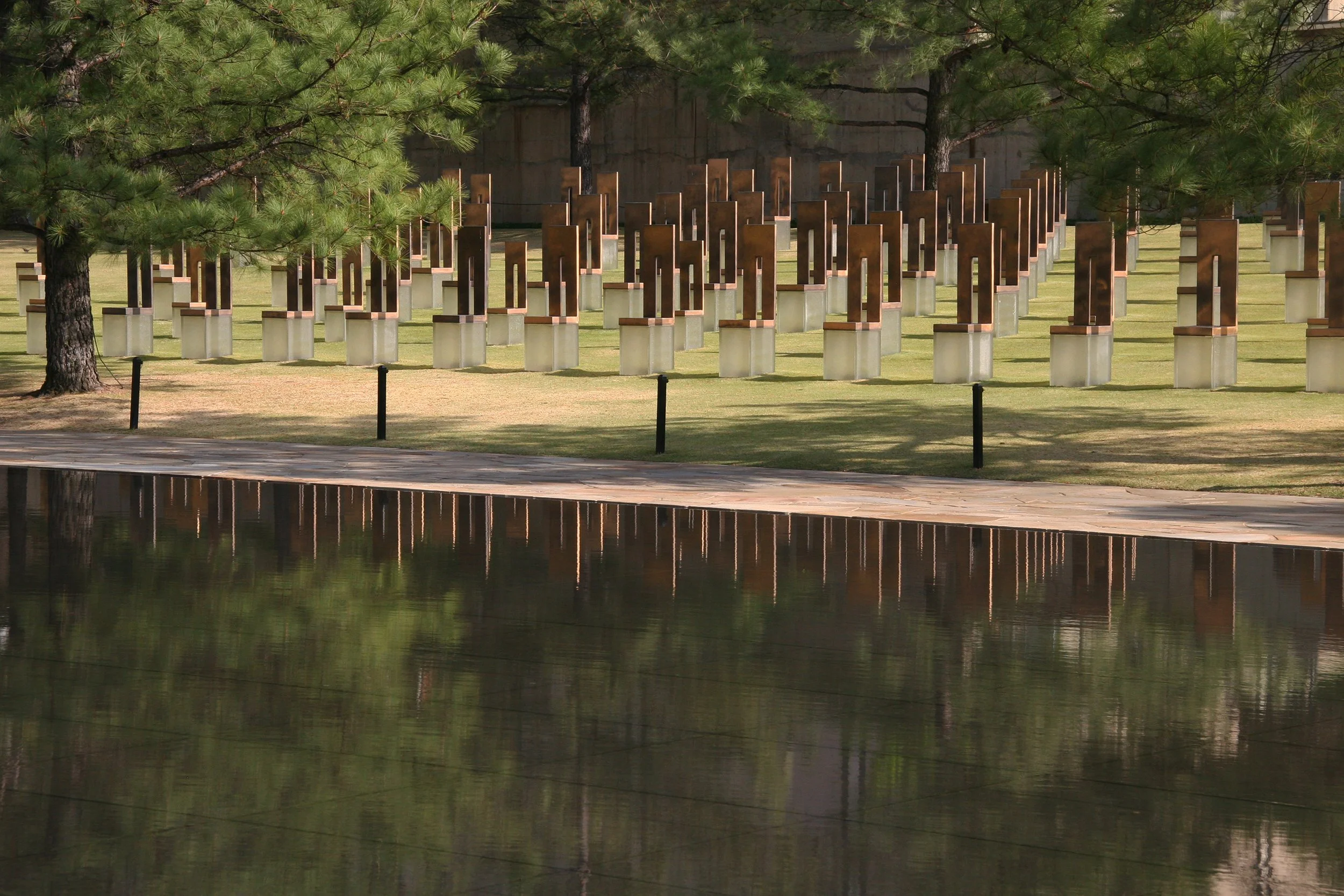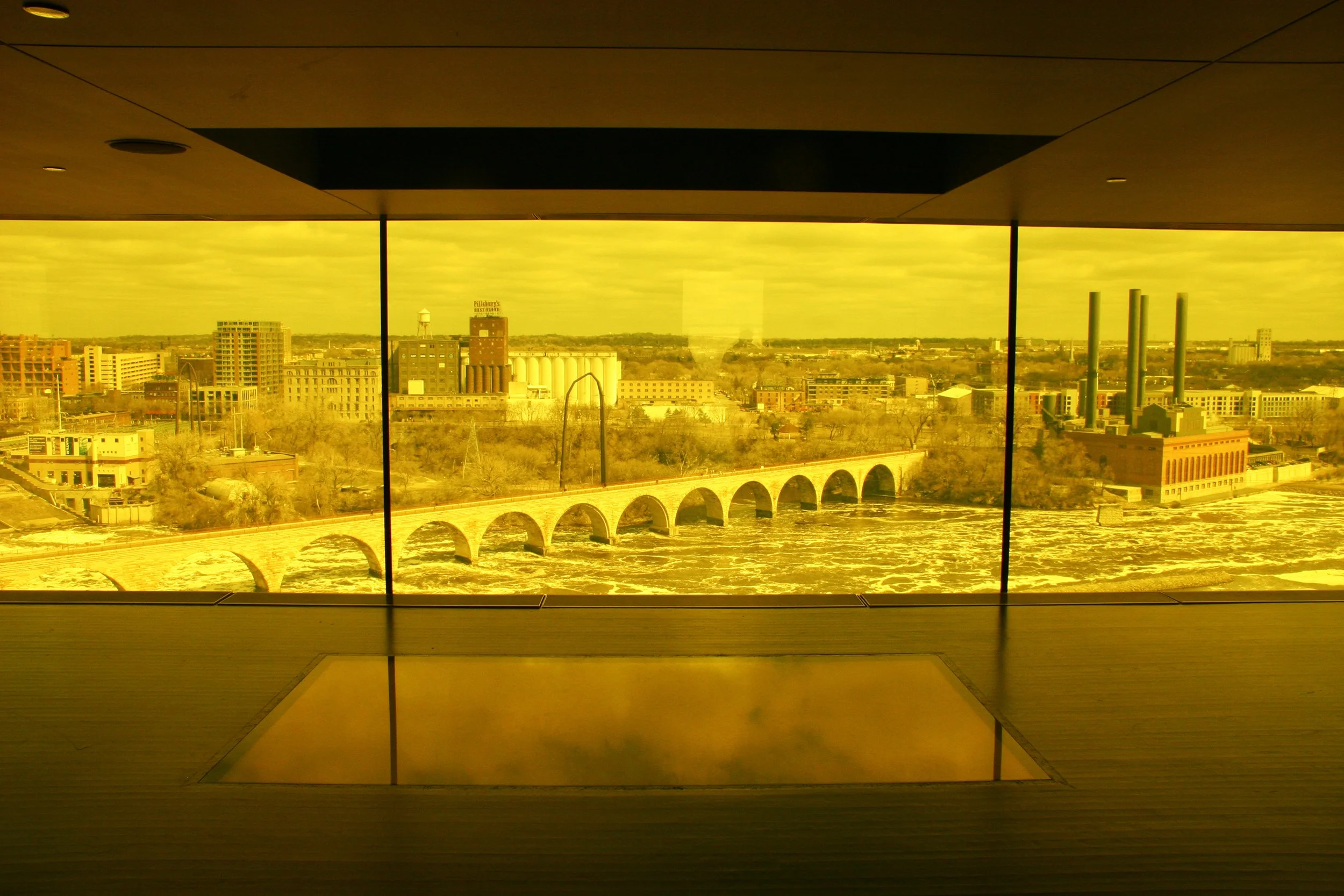
Page 2 of 5
Oklahoma City, Oklahoma
I'm waiting and fading and floating away
Home to the worst terrorist attack on American soil (at least for the six years between that bombing and the suicide plane attacks on September 11, 2001), the Oklahoma City National Memorial occupies the former site of the Alfred P Murrah Federal Building. For reference, the current reflecting pool occupies the site of the 5th Street and the grassy field with chairs occupies the site of the building. The proximity of the nine story concrete building to 5th Street proved to be its demise, all it took was a Ryder truck full of explosives parked right out front to selfishly change way too many lives forever.
As for the memorial (designed by Hans Butzer, Torrey Butzer and Sven Berg) is all symbolism all the time, a root problem of modern memorial design that's hard to shake. The biggest and most well known of the gestures are the empty chairs, one per victim, each inscribed with a victim's name with smaller chairs representing younger victims at the Federal Building's day care center. Chairs are arranged in rows representing deaths per floor and then loosely arranged again so that from higher floors in the building across the street they begin to form the abstract shape of the destruction to the building (in elevation), symbolically filling in the building and making it complete again. See, all symbolism all the time.
The reason why the view from higher floors in the building across the street (right past the "Survivor Tree") is important is that it now contains the memorial's museum, a major attraction that features a collection of artifacts, photos, video and recordings to remind everyone of the horrors of the attack. A depressing but important endeavor, and something that is a constant reminder of just how difficult visiting that eventual World Trade Center memorial museum will be. Sure looking at twisted steel beams and everyday crushed artifacts is interesting, but the stories behind them can be and usually are just soul crushing in every imaginable way.
More symbolism at the memorial where each end of the reflecting pool is framed by a gate, one at 9:01 (representing the calm before the attack) and 9:03 (representing the start of the recovery). Oddly the 9:03 is located on the side of the memorial where executed terrorist Timothy McVeigh entered the site, but I'm sure there's a strong symbolic reason for it.
The real power of the memorial in Oklahoma City is hard to photograph, one of the reasons you always see the all of those easy to photograph empty chairs. Despite the fact that the Murrah Federal Building was demolished, evocative pieces and partial ruins remain including the rear wall in the photo and the building's entire concrete plaza/garden on 4th Street.
Part of my continuing series of US State Capitol Buildings, including Saint Paul (Minnesota), Austin (Texas) and Lincoln (Nebraska) even though I've oddly never even thought about going locally to Trenton (New Jersey).
The State Capitol Building in Oklahoma is in Oklahoma City but far, far, far from downtown in a college type of campus of state government buildings where security is a real concern (unlike Minnesota, Texas or Nebraska where they amazingly still don't even check backpacks). On an early Sunday morning in April I had the Capitol Building pretty much to myself, I'm pretty sure the only people in the building were me and the lonely (and thorough) security guard who was excited that someone had stopped by to visit. What everyone else was missing is a damn fine building filled with surprising color and generally well designed spaces.
State of the art for 1970 and still drawing "what the hell is that" looks from up and down Sheridan Street, architect (and long time Pratt Institute guy) John Johansen's Stage Center complex is a series of erector set concrete and metal boxes loosely arranged in a mess of a composition. And while it may not be my favorite, it is still doing its job by looking crazy, new and experimental almost 40 years after opening. Hard to beat that.
Oklahoma City is more than just a memorial, capitol building, crazy theatre and one time home of Mickey Mantle and the Flaming Lips. There are also iconic buildings like the tilted glass cylinder conservatory at Myriad Gardens, a good collection of early 20th Century towers and a brand new riverwalk. Clearly inspired by (or ripped off from) San Antonio's riverwalk, the new landscaped canal connects downtown with a new entertainment district that stretched down past the Bass Pro Shop and Toby Keith restaurant and toward the interstate but (unlike San Antonio) oddly enough never connects at any point with an actual river.
We’ve left Oklahoma City and headed back east to New York for a good reason. This first picture is my first ever view of the first phase of the High Line Park, a former elevated freight rail line in Manhattan that has been converted into a public park (or possibly public promenade) by architects Diller, Scofidio + Renfro and landscape architects Field Operations. This first phase starts at Gansevoort Street, sneaks underneath James Stewart Polshek's Standard Hotel and then ends on West 20th Street. Even under a cloudy sky, the walk was wonderful, all of those great reviews you are reading seem to be right on the mark.

